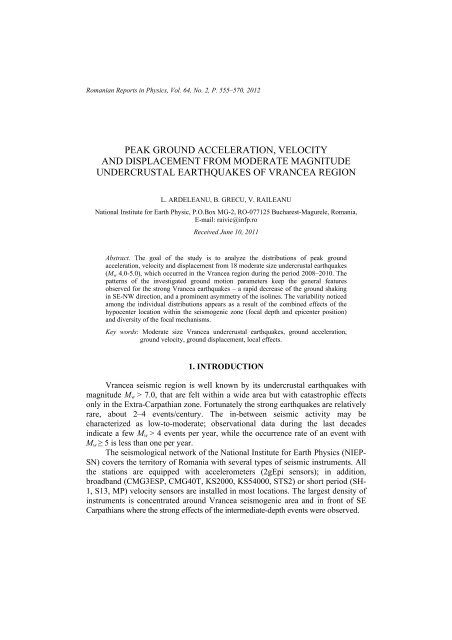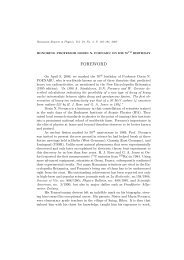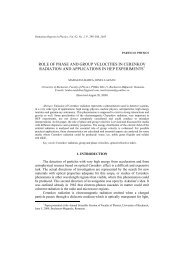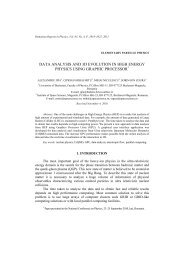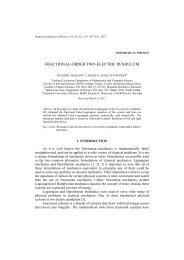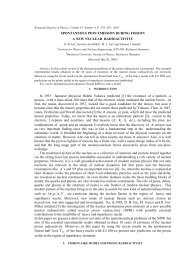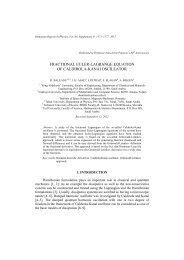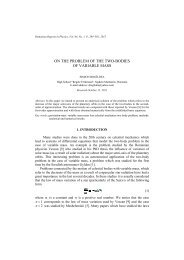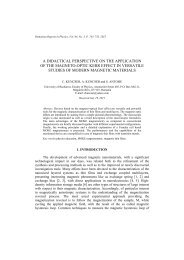peak ground acceleration, velocity and displacement from moderate ...
peak ground acceleration, velocity and displacement from moderate ...
peak ground acceleration, velocity and displacement from moderate ...
You also want an ePaper? Increase the reach of your titles
YUMPU automatically turns print PDFs into web optimized ePapers that Google loves.
Romanian Reports in Physics, Vol. 64, No. 2, P. 555–570, 2012<br />
PEAK GROUND ACCELERATION, VELOCITY<br />
AND DISPLACEMENT FROM MODERATE MAGNITUDE<br />
UNDERCRUSTAL EARTHQUAKES OF VRANCEA REGION<br />
L. ARDELEANU, B. GRECU, V. RAILEANU<br />
National Institute for Earth Physic, P.O.Box MG-2, RO-077125 Bucharest-Magurele, Romania,<br />
E-mail: raivic@infp.ro<br />
Received June 10, 2011<br />
Abstract. The goal of the study is to analyze the distributions of <strong>peak</strong> <strong>ground</strong><br />
<strong>acceleration</strong>, <strong>velocity</strong> <strong>and</strong> <strong>displacement</strong> <strong>from</strong> 18 <strong>moderate</strong> size undercrustal earthquakes<br />
(M w 4.0-5.0), which occurred in the Vrancea region during the period 2008–2010. The<br />
patterns of the investigated <strong>ground</strong> motion parameters keep the general features<br />
observed for the strong Vrancea earthquakes – a rapid decrease of the <strong>ground</strong> shaking<br />
in SE-NW direction, <strong>and</strong> a prominent asymmetry of the isolines. The variability noticed<br />
among the individual distributions appears as a result of the combined effects of the<br />
hypocenter location within the seismogenic zone (focal depth <strong>and</strong> epicenter position)<br />
<strong>and</strong> diversity of the focal mechanisms.<br />
Key words: Moderate size Vrancea undercrustal earthquakes, <strong>ground</strong> <strong>acceleration</strong>,<br />
<strong>ground</strong> <strong>velocity</strong>, <strong>ground</strong> <strong>displacement</strong>, local effects.<br />
1. INTRODUCTION<br />
Vrancea seismic region is well known by its undercrustal earthquakes with<br />
magnitude M w > 7.0, that are felt within a wide area but with catastrophic effects<br />
only in the Extra-Carpathian zone. Fortunately the strong earthquakes are relatively<br />
rare, about 2–4 events/century. The in-between seismic activity may be<br />
characterized as low-to-<strong>moderate</strong>; observational data during the last decades<br />
indicate a few M w > 4 events per year, while the occurrence rate of an event with<br />
M w ≥ 5 is less than one per year.<br />
The seismological network of the National Institute for Earth Physics (NIEP-<br />
SN) covers the territory of Romania with several types of seismic instruments. All<br />
the stations are equipped with accelerometers (2gEpi sensors); in addition,<br />
broadb<strong>and</strong> (CMG3ESP, CMG40T, KS2000, KS54000, STS2) or short period (SH-<br />
1, S13, MP) <strong>velocity</strong> sensors are installed in most locations. The largest density of<br />
instruments is concentrated around Vrancea seismogenic area <strong>and</strong> in front of SE<br />
Carpathians where the strong effects of the intermediate-depth events were observed.
556<br />
L. Ardeleanu, B. Grecu, V. Raileanu 2<br />
Taking advantage of the considerable amount of high quality data available<br />
we analyze the <strong>ground</strong> motion generated by 18 <strong>moderate</strong> size (4.0 ≤ M w ≤ 5.0)<br />
undercrustal earthquakes of Vrancea, occurred in the interval 2008–2010, with the<br />
aim of revealing peculiarities of the distributions of <strong>peak</strong> <strong>ground</strong> <strong>acceleration</strong>,<br />
<strong>velocity</strong> <strong>and</strong> <strong>displacement</strong>.<br />
2. SEISMIC EVENTS<br />
The study events occurred <strong>from</strong> January 1, 2008 to August 30, 2010. Our<br />
selection comprises earthquakes with M w ≥ 4.0, displaying records with high<br />
signal-to-noise ratio for at least 9 stations, a total number of 18 events (Fig. 1).<br />
Their basic parameters are listed in Table 1. The depths of foci range <strong>from</strong> 89 to<br />
158 km <strong>and</strong> the epicenters are located within an area of 20×60 km 2 . The statistics<br />
of the earthquakes is shown in Fig. 2.<br />
Fig. 1 – The stations of NIEP-SN (triangles) <strong>and</strong> the epicenters of the studied events (stars); the<br />
back<strong>ground</strong> – the topography map.
3 Undercrustal earthquakes of Vrancea region 557<br />
No<br />
Date<br />
(M.D.Y.)<br />
Origin<br />
time<br />
(h:m:s)<br />
Table 1<br />
Seismic events selected for analysis<br />
Latitude<br />
( 0 N)<br />
Longitude<br />
( 0 E)<br />
Depth<br />
(km)<br />
M w / M D<br />
1 01.30.2008 13:09:31 45.58 26.48 146 4.4 / 4.8<br />
2 02.09.2008 08:38:50 45.53 26.39 144 4.2 / 4.6<br />
3 02.11.2008 03:31:30 45.62 26.60 117 4.4 / 4.8<br />
4 05.25.2008 09:31:33 45.53 26.28 158 4.3 / 4.7<br />
5 05.31.2008 04:32:43 45.66 26.60 148 4.3 / 4.7<br />
6 07.04.2008 23:19:27 45.63 26.53 151 4.4 / 4.8<br />
7 07.16.2008 12:27:34 45.56 26.36 149 4.2 / 4.6<br />
8 10.02.2008 14:04:48 45.63 26.47 148 4.4 / 4.8<br />
9 12.01.2008 21:23:04 45.66 26.51 151 4.3 / 4.7<br />
10 12.17.2008 07:37:50 45.69 26.48 89 4.2 / 4.6<br />
11 04.25.2009 17:18:48 45.68 26.61 110 5.0 / 5.7<br />
12 05.12.2009 01:15:12 45.55 26.39 135 4.4 / 4.9<br />
13 05.27.2009 03:12:51 45.69 26.49 152 4.4 / 4.9<br />
14 06.27.2009 02:01:24 45.80 26.75 90 4.0 / 4.3<br />
15 07.24.2009 20:27:10 45.70 26.61 140 4.6 / 5.1<br />
16 12.26.2009 23:04:39 45.78 26.69 112 4.3 / 4.7<br />
17 02.25.2010 15:51:29 45.59 26.55 110 4.0 / 4.2<br />
18 06.08.2010 15:16:10 45.61 26.43 120 4.3 / 4.7<br />
Fig. 2 – The statistics of the studied events.<br />
The analysis is based on the waveforms recorded by the instruments of NIEP-<br />
SN (Table 2). The raw data – <strong>acceleration</strong> records, 3 components – are corrected<br />
for baseline <strong>and</strong> filtered by b<strong>and</strong>-pass in the frequency range 0.2–25 Hz. Ground<br />
velocities <strong>and</strong> <strong>displacement</strong>s are derived <strong>from</strong> <strong>acceleration</strong>s by integrating in time<br />
domain.
558<br />
L. Ardeleanu, B. Grecu, V. Raileanu 4<br />
Table 2<br />
Location of the stations of NIEP Seismic Network (NIEP-SN)<br />
Code Longitude ( 0 E) Latitude ( 0 N) Elevation (m) Locality/zone<br />
ARCR 24.35 47.09 356 Arcalia – Bistrita Nasaud<br />
ARR 24.63 45.37 924 Vidraru<br />
AMRR 27.34 44.61 86 Amara<br />
BANR 21.14 45.38 159 Banloc<br />
BAPR 26.12 44.41 103 Bucuresti – Parcul Copiilor<br />
BMR 23.50 47.67 227 Baia Mare<br />
BSTR 26.10 44.45 125 Bucuresti – COS<br />
BTMR 26.11 44.44 142 Bucuresti – GEOTEC<br />
BUC 26.09 44.41 95 Bucuresti – Cutitul de Argint<br />
BUC1 26.03 44.35 120 Bucuresti – Magurele<br />
BURAR 25.20 47.64 1217 Bucovina Array<br />
BVCR 26.10 44.43 109 Bucuresti – Curtea Veche<br />
BZS 21.64 45.62 260 Buzias<br />
CFR 28.14 45.18 57 Carcaliu<br />
CIOR 25.88 44.45 135 Ciorogarla<br />
CJR 23.60 46.71 750 Cluj<br />
CNCR 26.26 44.44 105 Cernica<br />
CRAR 23.80 44.33 125 Craiova<br />
CVD 28.04 44.35 153 Cernavoda<br />
DEV 22.90 45.89 249 Deva<br />
DOPR 25.39 45.97 544 Dopca<br />
DRGR 22.71 46.79 923 Valea Draganului<br />
EFOR 28.63 44.08 103 Eforie<br />
GRER 26.97 45.38 287 Greabanu<br />
GHRR 27.41 46.06 209 Gohor<br />
GOLR 24.98 44.84 300 Golesti<br />
GZR 22.78 45.39 850 Gura Zlata<br />
HARR 27.93 44.69 123 Harsova<br />
HUMR 24.98 44.53 247 Humele<br />
IAS 27.55 47.19 195 Iasi<br />
INCR 26.16 44.44 145 Bucuresti – INCERC<br />
ISR 26.54 45.12 791 Istrita<br />
LOT 23.77 45.45 1361 Lotru<br />
MANR 28.59 43.82 72 Mangalia<br />
MDB 24.38 46.15 423 Medias<br />
MLR 25.95 45.49 1392 Muntele Rosu<br />
MSAB 27.83 44.09 124 Manastirea Sfantul Andrei<br />
MTUR 25.07 45.23 1083 Matau<br />
ODBI 27.06 45.76 226 Odobesti<br />
PETR 27.23 45.72 85 Petresti<br />
PGOR 26.98 44.92 102 Pogoanele
5 Undercrustal earthquakes of Vrancea region 559<br />
Table 2 (continued)<br />
PLAR 26.03 44.91 212 Ploiesti Astra<br />
PLOR 26.65 45.85 680 Plostina Array<br />
PRAR 26.23 47.36 451 Petru Rares<br />
RMGR 22.69 44.66 119 Halanga<br />
RMVG 24.28 45.04 264 Ramnicu Valcea<br />
SECR 26.07 45.04 420 Seciu<br />
SIRR 21.66 46.27 544 Siria<br />
SIBR 24.18 45.81 463 Sibiu<br />
SRE 23.20 44.66 386 Strehaia<br />
SULR 26.25 44.68 129 Surlari<br />
TESR 26.65 46.51 375 Tescani<br />
TIM 21.22 45.74 134 Timisoara<br />
TLB 28.04 44.59 101 Topalu<br />
TIRR 28.41 44.46 77 Targusor<br />
TLCR 28.81 45.19 74 Tulcea<br />
VOIR 25.05 45.44 966 Voina<br />
VRI 26.73 45.87 475 Vrancioaia<br />
ZIMR 25.37 43.66 88 Zimnicea<br />
3. RESULTS<br />
Table 3 summarizes the highest values of the <strong>ground</strong> motion observed for<br />
each event. The maximum horizontal <strong>acceleration</strong>s, velocities <strong>and</strong> <strong>displacement</strong>s<br />
belong preponderantly to the S-wave train, which carries the most part of the<br />
seismic energy, while the maximum vertical values occur equally in the S- <strong>and</strong><br />
P-wave trains.<br />
M.D.Y.<br />
Mw/<br />
depth<br />
[km]<br />
01.30.2008<br />
4.4/146<br />
02.09.2008<br />
4.2/144<br />
02.11.2008<br />
4.4/117<br />
05.25.2008<br />
4.3/158<br />
05.31.2008<br />
4.3/148<br />
Table 3<br />
Peak <strong>ground</strong> <strong>acceleration</strong>, <strong>velocity</strong> <strong>and</strong> <strong>displacement</strong> for the studied events.<br />
M.D.Y. = month, day, year<br />
Peak <strong>ground</strong><br />
<strong>acceleration</strong> PGA [cm/s 2 ]<br />
Peak <strong>ground</strong><br />
<strong>velocity</strong> PGV [mm/s]<br />
Peak <strong>ground</strong><br />
<strong>displacement</strong> PGD [µm]<br />
horizontal *) vertical horizontal *) vertical horizontal *) Vertical<br />
1.19-ODBI<br />
0.76-CVD<br />
0.39-ODBI<br />
0.33-VRI<br />
1.98-IAS<br />
1.49-ODBI<br />
0.36-CFR<br />
0.26-BUC1<br />
1.36-ODBI +<br />
0.68-CFR<br />
2.38-ODBI +<br />
1.44-CVD +<br />
0.35-ODBI<br />
0.19-BUC1<br />
0.47-ODBI 0.12-VRI<br />
0.18-CVD 0.09-ODBI<br />
1.54-IAS 0.65-VRI<br />
0.78-ODBI 0.54-BUC<br />
0.63-PETR + 0.13-BUC1<br />
0.14-AMRR 0.10-CFR<br />
1.81-ODBI +<br />
0.40-AMRR + 0.13-BUC1<br />
0.32-ODBI +<br />
0.24-CVD +<br />
13-ODBI<br />
4-CVD<br />
0.06-ODBI 5-CVD<br />
0.04-CVD 3-ODBI<br />
0.28-IAS 24-BUC<br />
0.21-CVD + 20-ODBI<br />
0.08-PETR + 4-AMRR<br />
0.04-CFR 4-CVD<br />
0.25-ODBI +<br />
0.09-CVD + 5-AMRR<br />
8-CVD +<br />
8-ODBI +<br />
2-CVD<br />
1-ODBI<br />
7-IAS<br />
7-ODBI<br />
2-CFR<br />
2-CVD<br />
5-ODBI +<br />
4-CVD +
560<br />
L. Ardeleanu, B. Grecu, V. Raileanu 6<br />
Table 3 (continued)<br />
07.04.2008<br />
4.4/151<br />
1.56-PETR<br />
1.46-CFR<br />
1.99-ODBI +<br />
1.07-PETR +<br />
0.61-PETR<br />
0.35-ODBI<br />
0.41-ODBI +<br />
0.17-PETR +<br />
30-PETR<br />
15-GRER<br />
10-ODBI +<br />
5-PETR<br />
07.16.2008<br />
4.2/149<br />
0.74-PETR<br />
0.51-ODBI<br />
1.16-ODBI +<br />
0.61-PETR +<br />
0.19-PETR<br />
0.09-BUC1<br />
0.21-ODBI +<br />
0.10-PETR +<br />
5-SULR<br />
4-CVD<br />
4-ODBI<br />
2-CVD<br />
10.02.2008<br />
4.4/148<br />
1.18-SECR<br />
0.80-ODBI<br />
0.90-ODBI +<br />
0.59-CVD +<br />
0.37-SECR<br />
0.28-ODBI<br />
0.30-ODBI +<br />
0.14-SECR<br />
23-SECR<br />
16-GRER<br />
10-ODBI +<br />
5-SECR<br />
12.01.2008<br />
4.3/151<br />
0.59-ODBI +<br />
0.38-SECR<br />
1.43-ODBI +<br />
1.04-PETR +<br />
0.21-SECR<br />
0.17-HUMR<br />
0.23-ODBI +<br />
0.15-PETR +<br />
13-SULR<br />
13-HUMR<br />
7-ODBI +<br />
3-SULR<br />
12.17.2008<br />
4.2/89<br />
3.62-SECR<br />
3.09-CNCR<br />
1.92-PGOR<br />
1.86-SURL +<br />
1.43-SECR<br />
0.87-PGOR<br />
0.41-SECR<br />
0.38-SULR +<br />
94-SECR<br />
60-PGOR<br />
15-SECR<br />
13-SULR +<br />
04.25.2009 55.10-SECR 30.05-ODBI + 23.94-SECR 6.76-ODBI + 3570-SECR 508-SECR<br />
5.0/110 28.68-SULR 27.93-PETR + 19.06-SULR 5.74-SECR + 2204-SULR 470-ODBI +<br />
05.12.2009<br />
4.4/135<br />
2.08-PETR<br />
1.74-ODBI<br />
1.74-PGOR<br />
1.51-PETR<br />
0.68-GRER<br />
0.64-PETR<br />
0.27-PETR<br />
0.22-GRER<br />
40-GRER<br />
35-VRI<br />
8-PETR<br />
8-GRER<br />
05.27.2009 4.15-CNCR 7.53-PETR + 1.76-BUC1 1.18-PETR + 87-BUC1 30-ODBI +<br />
4.4/152 4.13-BUC1 4.57-PGOR + 1.46-PLAR 1.03-ODBI + 78-PLAR 23-PETR +<br />
06.27.2009<br />
4.0/90<br />
1.31-PETR<br />
1.21-SECR<br />
0.97-PETR<br />
0.95-IAS<br />
0.46-SECR<br />
0.35-PETR<br />
0.18-IAS<br />
0.16-PETR<br />
25-SECR<br />
17-PETR<br />
5-VRI +<br />
3-SECR<br />
07.24.2009<br />
4.6/140<br />
5.20-CNCR<br />
3.70-PETR<br />
4.21-ODBI<br />
2.76-PETR<br />
1.42-CNCR<br />
0.84-VRI<br />
0.62-ODBI<br />
0.43-PETR<br />
63-ODBI<br />
43-CVD<br />
15-ODBI<br />
15-TIRR<br />
12.26.2009<br />
4.3/112<br />
7.25-SECR<br />
4.67-SULR<br />
2.59-SECR<br />
2.04-GRER +<br />
2.11-SECR<br />
1.55-GHRR<br />
0.50-SECR<br />
0.37-SULR<br />
115-SECR<br />
79-GHRR<br />
18-SECR<br />
14-GHRR<br />
02.25.2010<br />
4.0/110<br />
2.73-CNRC<br />
2.27-SECR<br />
2.18-CNRC<br />
1.90-PGOR<br />
0.87-SECR<br />
0.44-CNCR<br />
0.32-PGOR +<br />
0.31-CNCR<br />
51-SECR<br />
24-SULR<br />
10-SECR<br />
7-SULR<br />
06.08.2010<br />
4.3/119<br />
10.60-SECR<br />
5.01-CIOR<br />
4.27-SULR<br />
3.04-SECR<br />
3.84-SECR<br />
1.98-CIOR<br />
0.78-SULR<br />
0.77-SECR<br />
146-SECR<br />
134-SULR<br />
38-AMRR +<br />
31-SECR<br />
*) maximum value of two horizontal components; + maximum value observed in the P-wave train.<br />
Depending on the amount of good quality data available, gross or detailed<br />
pictures of the space distribution of <strong>peak</strong> <strong>ground</strong> <strong>acceleration</strong>, <strong>velocity</strong>, <strong>and</strong><br />
<strong>displacement</strong> were obtained for each of the study earthquakes.<br />
Generally, the amplitude of <strong>ground</strong> shaking generated by earthquakes at a<br />
particular site is determined by the characteristics of the seismic source (earthquake<br />
size, focal mechanism), the seismic wave propagation <strong>from</strong> the source to the site<br />
(focal distance, physical properties of the medium along the ray path), <strong>and</strong> the local<br />
site effects (local geology).<br />
The attenuation laws used in the assessment of the seismic hazard relate, by<br />
different functional forms, the predicted values of the <strong>ground</strong> motion parameters<br />
(<strong>peak</strong> <strong>acceleration</strong>, <strong>velocity</strong>, <strong>displacement</strong>) to the earthquake size, generally<br />
quantified by the magnitude, <strong>and</strong> the relative position of the site <strong>and</strong> seismic source<br />
(hypocentral distance, or epicentral distance <strong>and</strong> focal depth).<br />
Besides the earthquake magnitude <strong>and</strong> the focus-to-site distance, important<br />
contributions to the spatial distribution of <strong>ground</strong> motion parameters have the focal
7 Undercrustal earthquakes of Vrancea region 561<br />
mechanism – especially in the case of large events, with finite source – <strong>and</strong> the<br />
attenuation properties of the seismic waves along the travel path due to elastic<br />
scattering on inhomogeneities <strong>and</strong> inelasticity of rocks – effects incorporated in the<br />
parameter Q, the quality factor of the medium.<br />
Finally, the local geology may also play a major role in the level of <strong>ground</strong><br />
shaking at a specific site, as it can favor the increasing of seismic wave amplitudes<br />
up to a few times comparatively to the values at the top of the basement; significant<br />
amplification of seismic vibrations may take place in certain situations, for<br />
properly related values of seismic wavelengths, thickness of layers, wave <strong>velocity</strong><br />
<strong>and</strong> density within the shallow sedimentary pack.<br />
Detailed studies of the strong Vrancea earthquakes (M w > 6.5) occurred<br />
during the second half of the XX th century – performed using both macroseismic<br />
<strong>and</strong> instrumental data (e.g. [1–7]) – revealed some common features of the <strong>ground</strong><br />
motion caused by these large events, irrespective of the focal depth (in the upper or<br />
lower part of the undercrustal seismogenic region) or particularities of the source<br />
mechanism: (i) large values of <strong>ground</strong> motion parameters observed over wide areas<br />
orientated predominantly NE-SW; (ii) strong, abnormal attenuation of the seismic<br />
waves propagating towards the Intra-Carpathian zone.<br />
The observed PGAs, PGVs <strong>and</strong> PGDs <strong>from</strong> the investigated <strong>moderate</strong> size<br />
earthquakes comply with this pattern.<br />
The values of <strong>ground</strong> motion parameters observed in the Transylvanian<br />
region are lower then those recorded in the Extra-Carpathian area (at comparable<br />
epicentral distances), by at least one order of magnitude generally.<br />
The strongest seismic motion does not occur at the sites located in the<br />
epicentral zone – in the mountain area –, but at stations situated at tens of km apart<br />
<strong>from</strong> the epicenter, indicating that the level of <strong>ground</strong> shaking is strongly<br />
controlled by the local <strong>and</strong> regional geological conditions. Large amplitudes are<br />
pointed out in the Focşani Basin (at the seismic stations ODBI <strong>and</strong> PETR), as well<br />
as in several locations in the Moesian Platform (the stations SECR, PLAR, PGOR,<br />
SULR, CNCR, CIOR, BTMR, BAPR, BUC1, HUMR), Scythian Platform (CFR,<br />
GHRR stations) <strong>and</strong> Moldavian Platform (IAS station).<br />
Differences in the patterns of PGA, PGV <strong>and</strong> PGD displayed by individual<br />
earthquakes are caused by differences in the focal mechanisms <strong>and</strong>/or ray paths<br />
<strong>from</strong> source to recording points.<br />
An example is shown in Fig. 3, two events with focal mechanisms <strong>and</strong><br />
hypocenter locations differing significantly. For the event #15, the maximum<br />
horizontal <strong>acceleration</strong> was recorded at CNCR station, situated in the eastern part<br />
of the Wallachian sector of the Moesian Platform, but significantly large values<br />
were also observed at the stations <strong>from</strong> the Focşani Depression: PETR <strong>and</strong> ODBI,<br />
as well as at CFR station, in the North Dobrogea Orogen. In the case of the event
562<br />
L. Ardeleanu, B. Grecu, V. Raileanu 8<br />
#18, the highest horizontal <strong>acceleration</strong>s were recorded SW of the epicenter, at<br />
SECR station in Carpathians foredeep, <strong>and</strong> at SULR <strong>and</strong> CIOR stations in the<br />
Moesian Platform.<br />
To reduce the pattern variation related to the variation of the propagation<br />
paths, we compared near events, situated only few km apart each other. Fig. 4<br />
shows two earthquakes localized in the deepest segment of the seismogenic zone, 4<br />
km apart one another, <strong>and</strong> Fig. 5 presents two shallower events with the<br />
hypocenters spaced apart by 11 km. In both cases, the noticeable differences in the<br />
pattern of the <strong>ground</strong> shaking should be attributed to a great extent to the<br />
contribution of the focal mechanisms, which differ considerably.<br />
The source location within the seismogenic region has also an important<br />
effect on the <strong>ground</strong> motion field. Fig. 6 displays the distribution of the PGAs for<br />
two events with similar mechanisms, located in the same depth range, 24 km apart<br />
one another. The fault plane solutions of the events #9 (Fig. 4, up) <strong>and</strong> #11 (Fig. 5,<br />
up) are almost identical; their sources are situated at different depths, <strong>and</strong> are<br />
separated by 42 km. The events #13 (Fig. 4, down) <strong>and</strong> #18 (Fig. 3, down) have<br />
also quite similar focal mechanisms; they occurred at different depths <strong>and</strong> are<br />
spaced by 34 km. All three pairs of events exhibit appreciable differences in the<br />
distribution of <strong>ground</strong> shaking.<br />
We notice that all the studied events are <strong>moderate</strong> sized (14 out of 18 having<br />
M w magnitude between 4.2 <strong>and</strong> 4.4), hence significant differences in their source<br />
spectral content, leading to notable variations of the local amplifications, are very<br />
unlikely.<br />
The collected records at SECR station (accelerograms available for 8 events)<br />
display repeatedly the highest observed values of PGA, or amplitudes close to the<br />
highest ones (up to an order of magnitude larger than those observed at the<br />
neighboring stations PLAR <strong>and</strong> ISR). SECR station is situated SW of the<br />
seismogenic zone in the Carpathians foredeep, at epicentral distance in the range<br />
70 to 100 km; it is located on top of a complex structure of tectonised soft <strong>and</strong> hard<br />
sediments on the Moesian basement. The large amplifications here suggest a<br />
considerable (<strong>and</strong> spatially limited) effect of the peculiar local conditions.<br />
Data analysis reveals also relatively high values of the <strong>peak</strong> vertical<br />
<strong>acceleration</strong>, <strong>velocity</strong> <strong>and</strong> <strong>displacement</strong>. Vertical <strong>acceleration</strong>s exceeding the<br />
horizontal ones by a factor greater than 2 (amounting to 5) were recorded at the<br />
stations TESR, PGOR, PETR, AMRR, ODBI, CVD, INCR, HARR, BUC1,<br />
BANR, EFOR. Actually, vertical <strong>ground</strong> motion amplitudes slightly higher or<br />
comparable to the horizontal motions were observed at the majority of seismic<br />
stations.
9 Undercrustal earthquakes of Vrancea region 563<br />
Fig. 3 – Distribution of <strong>peak</strong> horizontal <strong>acceleration</strong> (cm/s 2 ) – maximum value of two horizontal<br />
components – for two events occurred about 26 km apart one another, <strong>and</strong> having considerably<br />
different focal mechanisms.<br />
The strongest event of the data set has M w magnitude 5.0; it occurred on April<br />
25, 2009 in the shallower zone of the Vrancea undercrustal seismogenic volume, at<br />
110 km depth. The highest values of the <strong>ground</strong> motion parameters were recorded
564<br />
L. Ardeleanu, B. Grecu, V. Raileanu 10<br />
at SECR station: PGA = 55.1 cm/s 2 , PGV = 23.94 mm/s <strong>and</strong> PGD = 3.57 mm (see<br />
Table 3). Large horizontal <strong>acceleration</strong>s were also observed at the stations SULR<br />
(epicentral distance ∆ = 155 km) – 28.7 cm/s 2 , BAPR (∆ = 147 km ) – 25.3 cm/s 2 , IAS<br />
(∆ = 183 km ) – 24.9 cm/s 2 .<br />
Fig. 4 – Distribution of <strong>peak</strong> horizontal <strong>acceleration</strong> (cm/s 2 ) – maximum value of two horizontal components –<br />
for two events occurred in the deepest part of the seismogenic region, 4 km apart one another.<br />
The large number of high quality records of this earthquake allowed us to<br />
build up the maps of PGA, PGV <strong>and</strong> PGD for the territory of Romania. Fig. 7<br />
displays the map of <strong>peak</strong> horizontal <strong>acceleration</strong> (maximum value of two
11 Undercrustal earthquakes of Vrancea region 565<br />
horizontal components) obtained using a special interpolation algorithm <strong>and</strong> the<br />
plotting tools provided by the Generic Mapping Tools (GMT) [8]. It should be<br />
stressed that data are collected only <strong>from</strong> national seismic stations, therefore the<br />
map is reliable only for the area inside the Romanian borders. The pattern of the<br />
recorded <strong>peak</strong> <strong>ground</strong> <strong>acceleration</strong> – with maxima in the Carpathians foredeep<br />
close to Ploieşti city, <strong>and</strong> in the Moldavian Platform – is remarkably similar to the<br />
distribution observed in the case of the 6.0 M w magnitude earthquake of October<br />
27, 2004 (e.g. [9]), the largest intermediate depth event since the two strong seisms<br />
of May 30, <strong>and</strong> May 31, 1990 (M w = 6.9 <strong>and</strong> 6.4, respectively). The event of October<br />
27, 2004 occurred about 15 km to NE <strong>from</strong> our study event, at 99 km depth.<br />
Fig. 5 – Distribution of <strong>peak</strong> horizontal <strong>acceleration</strong> [cm/s 2 ] – maximum value of two horizontal components –<br />
for two events occurred in the shallower part of the seismogenic region, 11 km apart one another.
566<br />
L. Ardeleanu, B. Grecu, V. Raileanu 12<br />
On the basis of several hundred weak, <strong>moderate</strong> <strong>and</strong> strong-motion records of<br />
Vrancea intermediate depth events (about 100 earthquakes with M w magnitude less<br />
than 5.5 occurred during the period 1996–2004, <strong>and</strong> five shocks with M w in the<br />
range 6.0 to 7.4, occurred between 1977 <strong>and</strong> 2004), <strong>and</strong> taking also into account<br />
the geological <strong>and</strong> geomorphological characteristics on the territory of Romania,<br />
Sokolov et al. [10] proposed a zonation consisting in eight distinctive regions –<br />
namely (1) North, (2) East, (3) Focşani, (4) Vrancea, (5) South, (6) Southwest, (7)<br />
Rock (Mountain), <strong>and</strong> (8) Transylvania – <strong>and</strong> derived empirical region-specific<br />
(azimuth-dependent) attenuation relations for the <strong>peak</strong> <strong>ground</strong> <strong>acceleration</strong> <strong>and</strong><br />
<strong>peak</strong> <strong>ground</strong> <strong>velocity</strong>. The relationships have the functional form (1):<br />
Fig. 6 – Distribution of <strong>peak</strong> horizontal <strong>acceleration</strong> [cm/s 2 ] – maximum value of two horizontal<br />
components – for two events with similar focal mechanisms.
13 Undercrustal earthquakes of Vrancea region 567<br />
( )<br />
ln X = a + a ln M − exp a + a ln h R+ a h,<br />
(1)<br />
1 2 3 4 5<br />
where X is the <strong>ground</strong> motion parameter (PGA [cm/s 2 ], or PGV [cm/s]), M is the<br />
moment magnitude, h is the source depth (km), <strong>and</strong> R is the epicentral distance<br />
(km). The coefficients a 1 – a 5 were determined for each of the eight regions<br />
separately, by fitting the <strong>ground</strong> motion simulated by a stochastic technique [11]<br />
using the regional Fourier amplitude spectra (FAS); regional FAS were estimated<br />
by considering source scaling factors <strong>and</strong> attenuation models appropriate for<br />
Vrancea earthquakes, <strong>and</strong> generalized amplification functions evaluated for each<br />
zone. Equations (1) were developed for M values ranging <strong>from</strong> 5 to 8, focal depths<br />
h in the range 60 to 160 km, <strong>and</strong> epicentral distances R up to 500 km.<br />
Fig. 7 – Map of <strong>peak</strong> horizontal <strong>acceleration</strong> [cm/s 2 ] – maximum value of two horizontal components<br />
– for the April 25, 2009 Vrancea earthquake, M w = 5.0. Epicenter is marked by a star.<br />
The <strong>peak</strong> <strong>ground</strong> <strong>acceleration</strong>s recorded during the M w = 5.0 event of April<br />
25, 2009 were compared with the values predicted by the relation (1), by<br />
considering both estimations – based on the mean <strong>and</strong> the mean plus one st<strong>and</strong>ard<br />
deviation of the generalized amplification functions [12, 10].<br />
The observed data <strong>from</strong> the regions (2) East, (4) Vrancea, (7) Rock<br />
(Mountain), <strong>and</strong> (8) Transylvania are fairly well reproduced by the <strong>ground</strong> motion<br />
values calculated using the mean generalized amplification functions; for the other<br />
zones – (1) North, (3) Focşani, (5) South, <strong>and</strong> (6) Southwest – the estimates based
568<br />
L. Ardeleanu, B. Grecu, V. Raileanu 14<br />
on the mean plus one st<strong>and</strong>ard deviation of the generalized amplification functions<br />
match better the observations.<br />
A few sites exhibit significantly higher amplitudes than the predicted ones<br />
(larger by a factor between 2 <strong>and</strong> 3): IAS station in region (1) <strong>and</strong> SECR <strong>and</strong> ZIMR<br />
stations in region (6); smaller deviations <strong>from</strong> the predicted values (PGA larger by<br />
a factor between 1.5 <strong>and</strong> 2) were also observed at several stations in region (6) –<br />
SULR, CNCR, BAPR, CIOR <strong>and</strong> HUMR.<br />
Obviously, equation (1), as any attenuation relationship, predicts only the<br />
general features of the <strong>ground</strong> shaking, not the peculiarities of particular<br />
earthquakes. Since the region-specific coefficients a 1 – a 5 were determined by<br />
using generalized source parameters (seismic moment <strong>and</strong> stress parameter) <strong>and</strong><br />
simple models of source scaling <strong>and</strong> inelastic attenuation, we expect that the<br />
predicted PGA values reflect average source characteristics of Vrancea<br />
intermediate depth events, together with average site effects in different regions.<br />
For SECR location the significant amplifications pointed out throughout the<br />
investigated data set indicate a dominant local effect. We note that the largest<br />
horizontal <strong>acceleration</strong> recorded at SECR station during the 6.0 M w magnitude<br />
event of October 27, 2004 was 265 cm/s 2 , close to the largest values observed<br />
during the strong earthquakes of 1977, 1986 <strong>and</strong> 1990.<br />
In the case of the remaining stations (IAS <strong>and</strong> ZIMR), it seems reasonable to<br />
assume that the high values of the observed <strong>ground</strong> motion reflect also a significant<br />
effect of the source mechanism.<br />
4. DISCUSSION<br />
A study of the <strong>ground</strong> shaking produced by 18 Vrancea <strong>moderate</strong> size<br />
undercrustal earthquakes, occurred during the period 2008–2010, is performed<br />
using the records of the seismic network of the National Institute for Earth Physics.<br />
The strongest event of the data set has M w magnitude 5.0; it occurred on<br />
April 25, 2009, at 110 km depth. The largest PGA was recorded at SECR station,<br />
55 cm/s 2 on North component; the highest values of PGV <strong>and</strong> PGD reached<br />
24 mm/s <strong>and</strong> 3.6 mm, respectively (see Table 3).<br />
For the remaining events (with M w magnitudes <strong>from</strong> 4.0 to 4.6, <strong>and</strong> depths in<br />
the range 89 – 158 km), the observed PGAs did not exceed 10 cm/s 2 , while the<br />
levels of the PGVs <strong>and</strong> PGDs were below 4 mm/s <strong>and</strong> 0.15 mm, respectively (see<br />
also Table 3).<br />
We summarize below, for comparison, the largest values of the PGA<br />
recorded during the major earthquakes occurred at the end of the XX th century; we<br />
note the small number of strong-motion records available for these events, due to<br />
the poor seismic instrumentation.<br />
– The earthquake of March 4, 1977, M w = 7.4: recorded at one single site in<br />
Bucharest city (at INCERC). PGA on the North component was 195 cm/s 2 , <strong>and</strong> on<br />
the East component 163 cm/s 2 .
15 Undercrustal earthquakes of Vrancea region 569<br />
– The earhquake of August 30, 1986, M w = 7.1: recorded at 20 sites, 5 of them<br />
in or around Bucharest city. The highest PGA values were observed at Focşani:<br />
288 cm/s 2 on the North component, <strong>and</strong> 207 cm/s 2 on the East component. Other<br />
large <strong>peak</strong> horizontal <strong>acceleration</strong>s (maximum value of two horizontal components)<br />
were recorded at Văleni – 191 cm/s 2 , Râmnicu Sărat – 165 cm/s 2 , Bucharest<br />
(Exhibition site) – 161 cm/s 2 , Oneşti – 156 cm/s 2 , Bucharest-Măgurele – 135 cm/s 2 .<br />
– The earthquake of May 30, 1990, M w = 6.9: recorded at 32 sites. The largest<br />
<strong>peak</strong> horizontal <strong>acceleration</strong>s (maximum value of two horizontal components) were<br />
observed at: Oneşti – 232 cm/s 2 , Periş – 224 cm/s 2 , Bolintin Vale – 209 cm/s 2 ,<br />
Râmnicu Sărat – 159 cm/s 2 <strong>and</strong> Vrâncioaia – 157 cm/s 2 .<br />
– The earthquake of May 31, 1990, M w 6.4: recorded at 24 sites. The highest<br />
values of the <strong>peak</strong> horizontal <strong>acceleration</strong> were observed at Focşani – 173 cm/s 2 ,<br />
Oneşti – 108 cm/s 2 , Vrâncioaia – 102 cm/s 2 .<br />
A major difference between the <strong>ground</strong> shaking caused by the strong Vrancea<br />
earthquakes (M w > 7.0), <strong>and</strong> the one induced by the <strong>moderate</strong> size seisms (M w<br />
around 5.0) consists in the dominating frequency of the vibrations: the large events<br />
usually produce low-frequency <strong>ground</strong> <strong>acceleration</strong>s (below 1 Hz), while the<br />
<strong>moderate</strong> events produce mostly <strong>ground</strong> <strong>acceleration</strong>s in the middle-to-high<br />
frequency range (above 2 Hz).<br />
The <strong>ground</strong> <strong>acceleration</strong> amplitude spectra obtained for the M w = 5.0 event of<br />
April 25, 2009, at stations located in all zones, exhibit maxima at frequencies<br />
ranging <strong>from</strong> 2 to 9 Hz.<br />
With regard to the distributions of PGAs, PGVs <strong>and</strong> PGDs recorded during<br />
the study events, they comply with the overall pattern displayed by the strong<br />
earthquakes of Vrancea [13, 14], which is characterized by a rapid decrease of the<br />
observed <strong>ground</strong> motion parameters in SE-NW direction, <strong>and</strong> a prominent<br />
asymmetry of the isolines. Although keeping the general trend determined by the<br />
regional geological conditions, the individual patterns show a noticeable<br />
variability, which may be attributed to the diversity of the focal mechanisms <strong>and</strong><br />
hypocenter position within the seismogenic zone, the effects of the source <strong>and</strong><br />
wave propagation path at the site being combined.<br />
The analysis points out a location which displays large amplifications of the<br />
seismic waves with frequencies in the middle-to-high range (greater than 2 Hz)<br />
produced by the <strong>moderate</strong> size undercrustal events of Vrancea. The high <strong>peak</strong><br />
<strong>ground</strong> <strong>acceleration</strong>s, velocities <strong>and</strong> <strong>displacement</strong>s observed constantly at SECR<br />
station point to a dominant effect of the particular local conditions at this site.<br />
Acknowledgments. The authors thank the anonymous referee, whose observations <strong>and</strong><br />
suggestions contributed to improving the manuscript. The research was supported by the National<br />
Authority for Scientific Research, Contract CNMP-31-018/2007, Contract CNMP-32157/2008,<br />
Contract 31N/ 23.01.2006, Project PN 06-31 01 03 <strong>and</strong> Contract PN09 30, Project PN09- 01 03.<br />
Partial support came <strong>from</strong> CNCSIS-UEFISCDI, project number PN II-RU 120/2010.
570<br />
L. Ardeleanu, B. Grecu, V. Raileanu 16<br />
REFERENCES<br />
1. N. Mândrescu, Geological hazard evaluation in Romania, Eng. Geol., 20, 39–47, 1984.<br />
2. C. Radu, A. Utale <strong>and</strong> V. Winter, The August 30, 1986 Vrancea earthquake. The distribution of the<br />
seismic intensity (in Romanian), Centre of Earth Physics <strong>and</strong> Seismology Report 30.86.3/1987,<br />
II, A-3, Bucharest, 1987.<br />
3. C. Radu <strong>and</strong> A. Utale, A new version of the March 4, 1977 Vrancea earthquake (in Romanian),<br />
Centre of Earth Physics <strong>and</strong> Seismology Report 30.86.3/1989, II, A4, 31–32, Bucharest, 1989.<br />
4. C. Radu <strong>and</strong> A. Utale, The Vrancea earthquake of May 30, 1990. Intensity distribution (in<br />
Romanian), Centre of Earth Physics Report 30.86.3/1990, IV, A2, Bucharest, 1990.<br />
5. C. Radu, D. Rădulescu <strong>and</strong> H. S<strong>and</strong>i, Some data <strong>and</strong> considerations on recent strong earthquakes<br />
of Romania, Cahier Technique, 3, AFPS, Paris, 1990, pp. 19–31.<br />
6. M.C. Oncescu, K.-P. Bonjer <strong>and</strong> M. Rizescu, Weak <strong>and</strong> strong <strong>ground</strong> motion of intermediate<br />
depth earthquakes <strong>from</strong> the Vrancea region, in: eds. F. Wenzel, D. Lungu, <strong>and</strong> O. Novak,<br />
Vrancea Earthquakes: Tectonics, Hazard <strong>and</strong> Risk Mitigation, Kluwer Academic Publishers,<br />
Dordrecht, The Netherl<strong>and</strong>s, 1999, pp. 27–42.<br />
7. N. Mândrescu <strong>and</strong> M. Radulian, Macroseismic field of the Romania intermediate depth<br />
earthquakes, in: F. Wenzel, D. Lungu, <strong>and</strong> O. Novak eds., Vrancea Earthquakes: Tectonics,<br />
Hazard <strong>and</strong> Risk Mitigation, pp. 163–174, Kluwer Academic Publishers, Dordrecht, The<br />
Netherl<strong>and</strong>s, 1999.<br />
8. P. Wessel <strong>and</strong> W. H. F. Smith, Free software helps map <strong>and</strong> display data, EOS Trans. Am.<br />
Geophys. Union, 72, 444–446, 1991.<br />
9. K.-P. Bonjer, C. Ionescu, V. Sokolov, M. Radulian, B. Grecu, M. Popa <strong>and</strong> E. Popescu, Ground<br />
motion patterns of intermediate-depth Vrancea earthquakes: the October 27, 2004 event, in:<br />
A. Zaicenko, I. Craifaleanu <strong>and</strong> I. Paskaleva eds. Harmonization of Seismic Hazard in Vrancea<br />
Zone, Springer, Dordrecht, The Netherl<strong>and</strong>s, 2008, pp. 47–62.<br />
10. V. Sokolov, K.-P. Bonjer, F. Wenzel, B. Grecu <strong>and</strong> M. Radulian, Ground-motion prediction<br />
equations for the intermediate depth Vrancea (Romania) earthquakes, Bull. Earthquake Eng.,<br />
6, 367–388, 2008.<br />
11. D. M. Boore, Simulation of <strong>ground</strong> motion using the stochastic method, Pure Appl. Geophys.,<br />
160, 635–676, 2003.<br />
12. V. Sokolov, K.-P. Bonjer <strong>and</strong> F. Wenzel, Accounting for site effect in probabilistic assessment of<br />
seismic hazard for Romania <strong>and</strong> Bucharest: a case of deep seismicity in Vrancea zone, Soil<br />
Dyn. Earthq. Eng., 24, 927–947, 2004.<br />
13. G. Marmureanu, C.O. Cioflan, A. Marmureanu, Intensity seismic hazard ap of Romania<br />
by probabilistic <strong>and</strong> (neo)deterministic approaches, linear <strong>and</strong> nonlinear<br />
analyses, Rom.Rep.Phys., 63, 1, 226–239, 2011.<br />
14. A. Pantea, A.P. Constantin, Reevaluated macroseismic map of Vrancea (Romania)<br />
earthquake occurred on November 10, 1940, Rom. Journ. Phys., 56, 3–4, 578–589, 2011.


